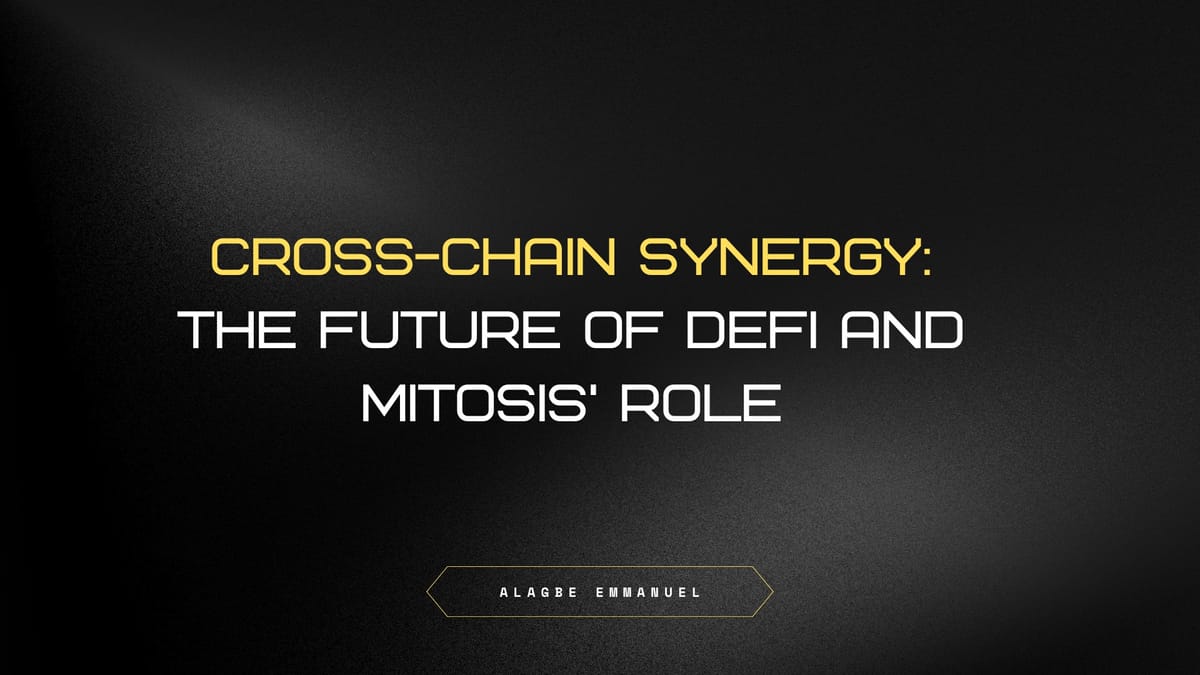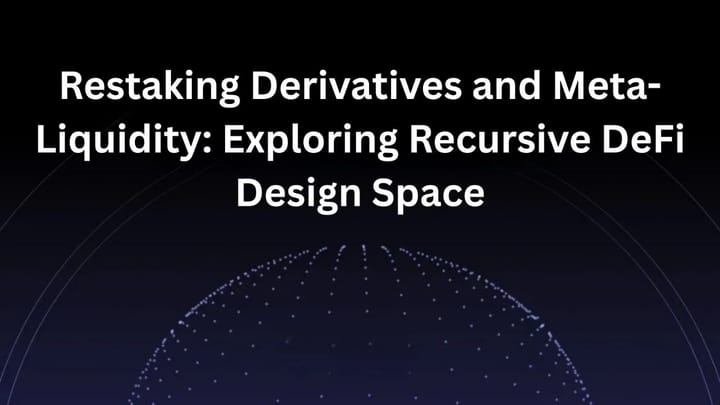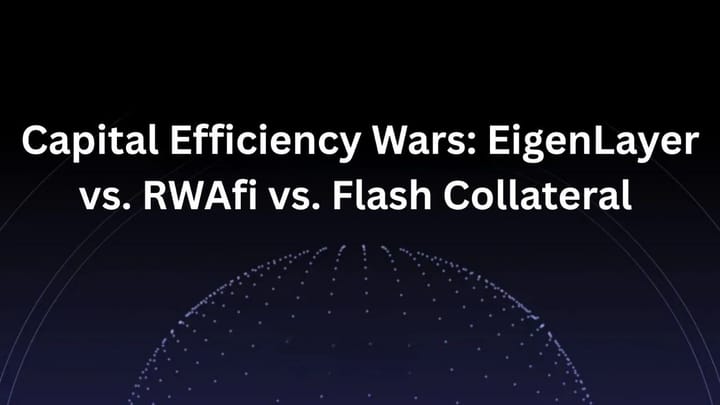Cross-Chain Synergy: The Future of DeFi and Mitosis’ Role

In the rapidly evolving world of decentralized finance (DeFi), one of the biggest challenges is cross-chain synergy , the ability for different blockchains to communicate, share assets, and execute transactions seamlessly. As the crypto ecosystem fragments across layer-1 (L1) chains like Ethereum, Solana, and modular solutions like Celestia, the need for unified liquidity and interoperability has never been greater. This is where Mitosis, an Ecosystem-Owned Liquidity (EOL) L1 blockchain, steps in to redefine how liquidity flows across chains.
What is cross-Chain Synergy
Cross-chain synergy refers to the ability of distinct blockchains to communicate and share data or value with one another. The challenge arises because each blockchain operates as an independent ledger, maintaining a permanent record of its users' transactions. For two blockchains to interact, they would need to synchronize their states and continuously track each other's transactions, which demands significant data exchange and storage, making scalability difficult. This issue compounds when multiple blockchain pairs attempt to connect.
Cross-chain synergy addresses this by enabling seamless data and value transfer between blockchains, acting as a direct bridge that removes the need for intermediaries, such as centralized exchanges (CEXs).
Why Cross-Chain Synergy Matters
Cross-chain synergy addresses several pain points in DeFi:
- Fragmented Liquidity: Assets locked in one chain can’t easily move to another, leading to poor capital efficiency and higher slippage in trades.
- User Experience: Users face complex processes like bridging assets, managing multiple wallets, and navigating different decentralized applications (dApps).
- Scalability: As new chains emerge, ensuring they can integrate with existing ecosystems is critical for adoption.
Projects like Hyperlane, LayerZero, and Axelar have made strides in cross-chain messaging and asset transfers. However, many solutions require centralized coordination or lobbying for chain support, limiting their scalability in a modular blockchain era. Mitosis, powered by Hyperlane, offers a unique approach by focusing on programmable liquidity and permission less synergy.
Challenges in Achieving Cross-Chain Synergy
Despite its potential, cross-chain synergy faces significant hurdles. Security is a top concern, as cross-chain bridges have been targets for hacks and exploits. Regulatory uncertainty also looms, with varying compliance requirements across jurisdictions complicating decentralized operations. Additionally, the technical complexity of ensuring seamless communication between blockchains with different consensus mechanisms and token systems requires innovative solutions.
Scalability and user experience are further challenges. Cross-chain transactions must be fast, cost-effective, and intuitive to drive mass adoption. Overcoming these obstacles demands robust protocols, standardized frameworks, and collaborative efforts between blockchain projects.
Mitosis: Redefining Liquidity Across Chains
Mitosis is designed to tackle the liquidity fragmentation problem head-on with its Ecosystem-Owned Liquidity (EOL) model. Here’s how it integrates with cross-chain synerGT:
- Liquidity as a Service:
Mitosis acts as a liquidity hub, allowing users to deposit assets (e.g., ETH, weETH) into Mitosis Vaults and receive miAssets (e.g., miweETH) at a 1:1 ratio. These miAssets are derivative tokens that can be used across supported chains like Ethereum, Arbitrum, and Optimism for various DeFi activities, such as yield farming or lending, without moving the underlying assets. This eliminates the need for repetitive bridging while enhancing capital efficiency. - Permissionless Interoperability with Hyperlane:
Mitosis leverages Hyperlane for its cross-chain messaging, enabling any chain with a Hyperlane deployment to connect to the Mitosis ecosystem. Unlike traditional interoperability providers, Hyperlane’s permissionless architecture allows developers to deploy it on any chain without centralized approval. Mitosis uses this to unify liquidity across modular chains, ensuring assets like TIA from Cosmos or ETH from Ethereum L2s can flow seamlessly. - Community-Driven Governance:
Mitosis’ EOL model empowers liquidity providers (LPs) to vote on how pooled liquidity is allocated across chains and protocols. This decentralized governance ensures that retail LPs can access institutional-grade opportunities, such as early access to rewards or better yield terms. By unifying yields across chains, Mitosis simplifies the decision-making process for LPs. - Enhanced Security:
Mitosis combines its Proof-of-Stake (PoS) security with restaked ETH to validate cross-chain messages. As the protocol’s Total Value Locked (TVL) grows, its economic security strengthens, making it a robust platform for cross-chain transactions. LPs can also stake their miAssets to secure Hyperlane’s messaging and earn governance tokens.
How Mitosis Stands Out
Unlike other synergy solutions that focus solely on asset transfers, Mitosis emphasizes liquidity scalability. By issuing miAssets, it allows LPs to participate in DeFi without locking their assets in a single chain, addressing both interoperability and capital efficiency. For example, a user can deposit weETH into a Mitosis Vault, receive miweETH, and use it on Arbitrum for trading while earning cross-chain yields—all without manual bridging.
Mitosis has already shown impressive traction, with $71.98M in TVL as of September 2024 and partnerships with dApps like Ether.fi, Symbiotic, and Hyperlane. Its Expedition campaigns further incentivize user participation by rewarding LPs with MITO points, which may convert to tokens upon mainnet launch.
The Broader Impact
Cross-chain synergy isn’t just a technical challenge—it’s a gateway to a more inclusive DeFi ecosystem. Mitosis’ approach aligns with the crypto ethos of composability and decentralization, enabling:
- New Chains to Bootstrap Liquidity: Modular blockchains can tap into Mitosis’ EOL pools to attract users and TVL.
- Retail Empowerment: LPs gain bargaining power through collective governance, leveling the playing field with institutional players.
- Seamless User Experience: Unified yields and miAssets reduce the complexity of multi-chain DeFi.
As the modular blockchain era accelerates, Mitosis is well-positioned to become a cornerstone of cross-chain liquidity. Its integration with Hyperlane and focus on EOL make it a standout in the interoperability landscape.
Conclusion
Cross-chain synergy is the cornerstone of DeFi’s future, breaking down barriers between blockchains to create a more connected, efficient, and inclusive financial ecosystem. Mitosis is leading this charge with its programmable liquidity framework, tokenized assets, and cross-chain vault architecture. By addressing liquidity fragmentation and empowering users with flexible, high-yield opportunities, Mitosis is redefining what DeFi can achieve.
As DeFi continues to evolve, Mitosis’ role as a pioneer in cross-chain synergy will be critical. Its vision of a unified DeFi landscape, backed by strategic partnerships and community-driven innovation, positions it to drive the next wave of decentralized finance. For users and developers looking to maximize their DeFi potential, Mitosis offers a gateway to a seamless, multi-chain future.


Comments ()